PROGRESS REPORT
Board of Trustees updated on enrollment, construction
During its regular meeting on Sept. 6-7, the East Carolina University Board of Trustees received an update on enrollment numbers for the 2018-2019 academic year. Total enrollment is 28,718 students, a decline of 413 from last fall.
Of those, 23,071 are undergraduates and 5,647 are graduate students.
“After five years of continuous expansion, we had a bit of a retraction this year,” said Provost Ron Mitchelson.
Positive notes from the enrollment numbers included a slight increase in enrollment of in-state students and significant increases in the average high school GPA and SAT scores of first-time, first-year students. Applications were up for first-time, first-year students, and the student population represents all 100 counties of North Carolina, with the largest numbers from Wake, Pitt and Mecklenburg counties.

Chancellor Cecil Staton accepts an award from Kristen Sawyer, district manager for American Red Cross, recognizing ECU for its efforts in support of blood donation.
ECU has worked successfully to increase its graduation rate, a positive trend that nevertheless produces a downward influence on total enrollment.
University administrators are already working to ensure that the past decade’s overall upward trend for enrollment continues. Co-admission agreements were recently signed with 17 community colleges, creating a smoother process and increased support for transfer students. The university is also increasing its efforts to promote Greenville as a great college town, said Chancellor Cecil Staton.
Over the past five years, ECU has enrolled 11-12 percent of in-state, degree-seeking undergraduate low-income students, and 16-17 percent of rural students in the UNC system. ECU enrolls students from all 50 states, the District of Columbia and 63 countries.
Administrators expect a $5 million reduction in state appropriations based on the funding formula for enrolled students.
“Our commitment is to protect the classroom,” Mitchelson said.
Several factors can be attributed to the drop in enrollment, including competition from out-of-state universities for in-state students, a declining U.S. birth rate, and a higher five-year graduation rate at ECU.
The number of high school graduates east of I-95 – traditionally a strong recruitment area for ECU – declined by 1.9 percent last year, and officials expect that trend to continue.
Applications to the Honors College remain high, and by fall 2019, the college will be at its designed size of 800 students (200 per class). All data reported by IPAR is preliminary, and an analysis of enrollment figures will be presented at the next Board of Trustees meeting on Nov. 1-2.
The board also received an update on the university’s major capital projects from Bill Bagnell, associate vice chancellor for campus operations. Bagnell reported that the new student center, southside stadium renovation and Greene Hall renovation are proceeding on schedule. A comprehensive renovation of Mendenhall, the former student center, is in the planning stages, with construction expected to begin in 2020.
During the University Affairs Committee meeting, the board received an update on the student appellate conduct process. Less than 1 percent of cases have resulted in suspensions or expulsions. Over the last four academic years, ECU has had 166 suspensions and 11 expulsions, with fewer than 30 appeals. Top offenses include drugs, sexual assault, endangerment and theft.
“It’s our last resort to remove a student from the university,” said Dr. Virginia Hardy, vice chancellor of student affairs.
“Given the size of our student body, these numbers are very low,” said trustee Deborah Davis. “So that says to me that you’re doing all you can to keep students in school.”
Any cases that warrant suspension are reviewed by a conduct board, a five-member panel chaired by a student.
Mark Wdowik, executive director of innovation and new ventures, was introduced. His role will include developing a microenterprise program and fund as part of an innovation hub being formed at ECU.
The board approved discontinuing the Institute of Coastal Science and Policy, whose functions will be assumed within the new Division of Coastal Studies, and approved renaming the Center for Sustainable Tourism, Natural Resources and Built Environment to the Center for Sustainable Energy and Environmental Engineering.
During the meeting of the Health Sciences Committee, Dr. Mark Stacy, dean of the Brody School of Medicine, reported that the school welcomed 86 new medical students, its largest class ever. The class is made up of 33 percent underrepresented minorities, and 55 percent of the class is female.
“So we’ve done a wonderful job of fulfilling our mission of educating students from underrepresented minority backgrounds and disadvantaged backgrounds,” he said.
Stacy said his goal is to put Brody in the top 100 of research schools.
He shared the division’s pride in Dr. Leigh Patterson being selected to be a 2018–19 Hedwig van Ameringen Executive Leadership in Academic Medicine fellow. The international fellowship recognizes her potential for executive leadership in academic medicine.
Along with Stacy, members of the Board of Trustees toured the College of Nursing and the College of Allied Health, visiting simulation labs and the site of a proposed nutrition kitchen designed to teach members of the community how to improve nutrition with limited resources and access to healthy eating options.
The Finance and Facilities Committee received a dashboard report from Sara Thorndike, vice chancellor for administration and finance, comparing ECU’s fund balances in a variety of categories to those of other institutions in the UNC System.
During his report to the board, Staton highlighted the accomplishments of ECU students, including Jay Li, an engineering student who has been awarded a $1,000 prize for his study of the use of 3D cameras for objective edema measurement. He could be awarded up to $250,000 if he continues to advance in the competition.
“Those are the kinds of things we bump into every day on our campus,” Staton said. “(ECU’s students) inspire us each and every day, and we want to celebrate their accomplishments.”

Dr. Maura McAuliffe, director of the nurse anesthesia concentration, shows board members the control room for a simulated operating room.
